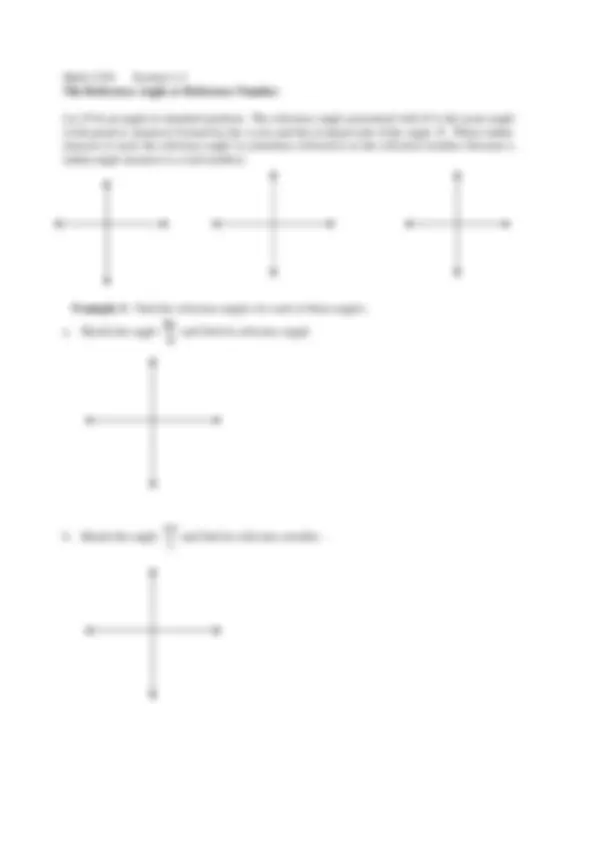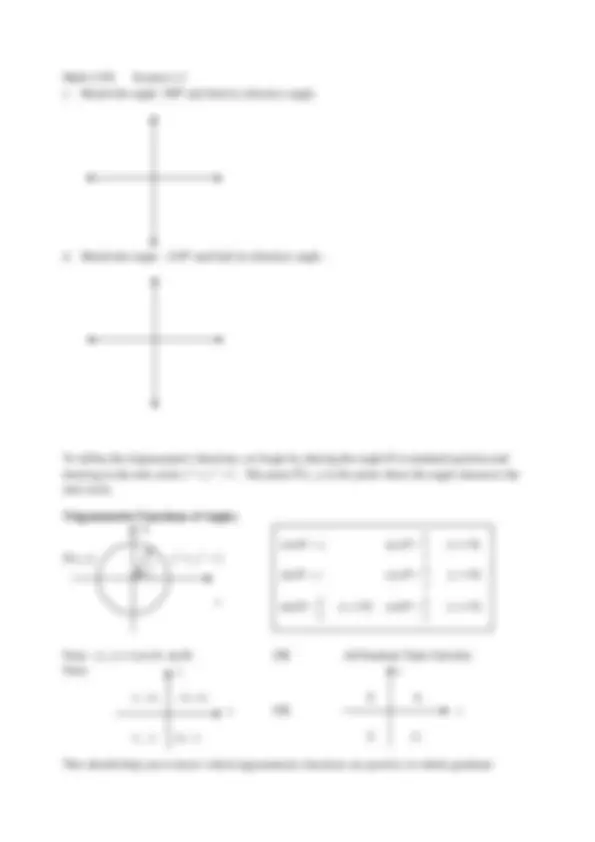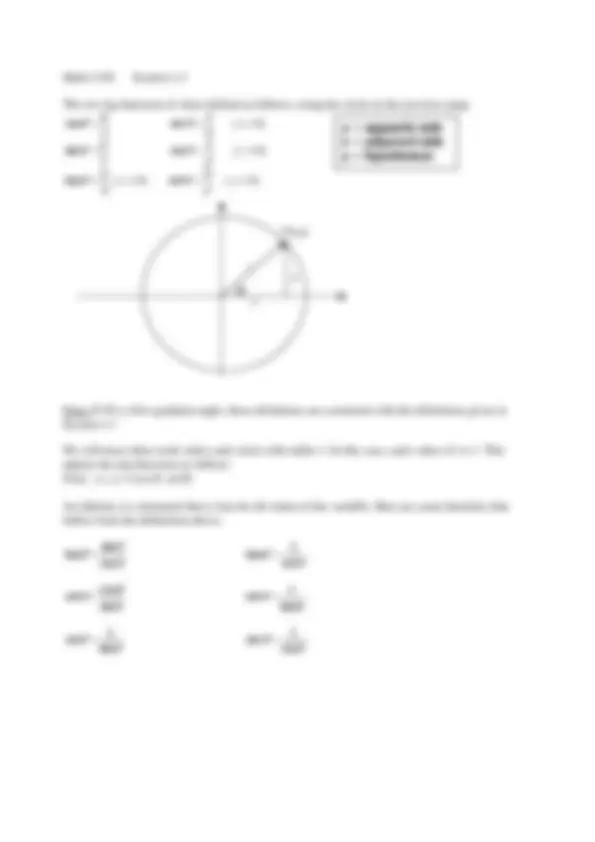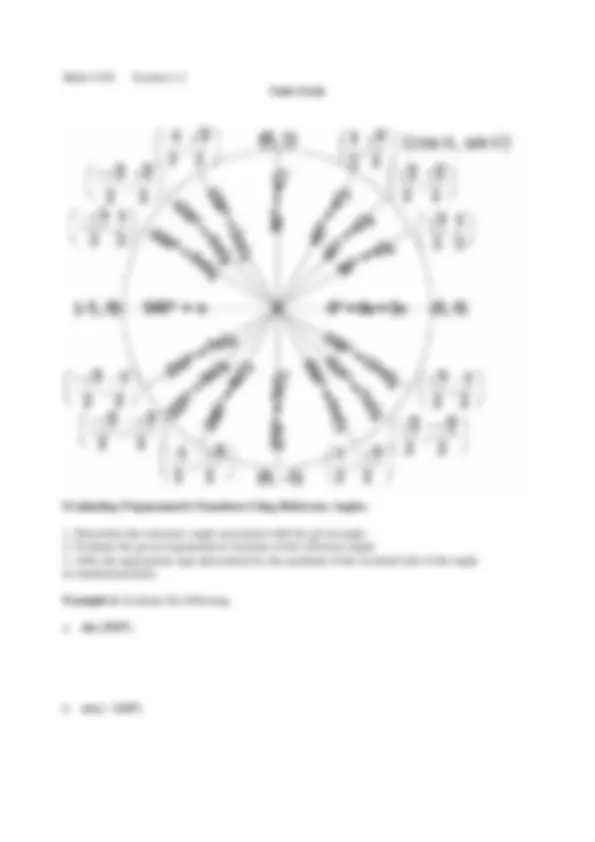








Study with the several resources on Docsity

Earn points by helping other students or get them with a premium plan


Prepare for your exams
Study with the several resources on Docsity

Earn points to download
Earn points by helping other students or get them with a premium plan
Community
Ask the community for help and clear up your study doubts
Discover the best universities in your country according to Docsity users
Free resources
Download our free guides on studying techniques, anxiety management strategies, and thesis advice from Docsity tutors
The concept of angles in standard position, coterminal angles, and the definition of trigonometric functions using the unit circle. It includes examples and identities.
Typology: Study notes
1 / 10

This page cannot be seen from the preview
Don't miss anything!







Section 4.3: Unit Circle Trigonometry
An angle is formed by two rays that have a common endpoint (vertex). One ray is called the initial side and the other the terminal side. A terminal angle can lie in any quadrant, on the x -axis or y - axis.
An angle is in standard position if the vertex is at the origin of the two-dimensional plane and its initial side lies along the positive x -axis.
Positive angles are generated by counterclockwise rotation. Negative angles are generated by clockwise rotation.
An angle in standard position whose terminal side lies on either the x- axis or the y- axis is called a quadrantal angle.
Example 1: Draw each angle in standard position.
a. 240 ° b. − 150 °
c. 3
7 π d. 4
− 5 π
Angles in standard position with the same terminal side are called coterminal angles. The measures of two coterminal angles differ by a factor corresponding to an integer number of complete revolutions.
The degree measure of coterminal angles differ by an integer multiple of 360 o^. For any angle θ measured in degrees, an angle coterminal with θ can be found by the formula (^) θ + n *360o^.
The radian measure of coterminal angles differ by an integer multiple of 2 π. For any angle θ measured in radians, an angle coterminal with θ can be found by the formula θ + n * 2π.
Example 2: Find three angles, two positive and one negative that are co-terminal with each angle.
a. (^) θ = 45 o^.
b. 6
π θ = −
c. Sketch the angle 300 o^ and find its reference angle.
d. Sketch the angle − 210 o^ and find its reference angle.
To define the trigonometric functions, we begin by placing the angle θ in standard position and
drawing in the unit circle x^2 + y^2 = 1. The point P ( x , y ) is the point where the angle intersects the unit circle.
Trigonometric Functions of Angles Y
P ( x , y ) x^2 + y^2 = 1
θ
x
Note: ( x , y ) = (cos θ ,sin θ ) OR All Students Take Calculus Note: y y
(-, +) (+, +) S A x OR x
(-, -) (+, -) T C
This should help you to know which trigonometric functions are positive in which quadrant.
cos θ = x sec x
θ = ( x ≠ 0 )
sin θ = y csc y
θ = ( y ≠ 0 )
tan x
y θ = ( x ≠ 0 ) cot y
x θ = ( y ≠ 0 )
The six trig functions of θ are defined as follows, using the circle on the previous page.
r
x cos θ = x
r sec θ = ( x ≠ 0 )
r
y sin θ = y
r csc θ = ( y ≠ 0 )
x
y tan θ = ( x ≠ 0 ) y
x cot θ = ( y ≠ 0 )
x
r y
P(x,y)
Note: If θ is a first quadrant angle, these definitions are consistent with the definitions given in Section 4.
We will most often work with a unit circle with radius 1. In this case, each value of r is 1. This adjusts the trig functions as follows: Note: ( x , y ) = (cos θ ,sin θ)
An identity is a statement that is true for all values of the variable. Here are some identities that follow from the definitions above.
θ
θ θ cos
sin tan = θ
θ cot
tan =
θ
θ θ sin
cos cot = θ
θ tan
cot =
θ
θ sin
csc = θ
θ cos
sec =
y = opposite side x = adjacent side y = hypotenuse
Trig Functions of Quadrant Angles and Special Angles
You will need to find the trig functions of quadrant angles and of angles measuring 30 ° , 45 ° or 60 ° without using a calculator.
Here is a simple way to get the first quadrant of trigonometric functions. Under each angle measure, write down the numbers 0 to 4. Next take the square root of the values and simplify if possible. Divide each value by 2. This gives you the sine values of each of the angles you need. To fine the cosine values, write the previous line in reverse order. Now find the tangent values by using the sine and cosine values
Angle in Degrees
Angle in Radians 0
Sine
Cosine
Tangent
Example 5: Let the point P(x, y) denote the point where the terminal side of angle θ (in standard position) meets the unit circle. Evaluate the six trig functions.
Suppose that 5
x = − and θ π π < < 2
. Find all 6 trig functions.
Unit Circle
Evaluating Trigonometric Functions Using Reference Angles
Example 6: Evaluate the following.
a. sin (300°)
b. cos (−240°)
h. sin 㐶−
i.
tan 䙲
6 䙳 − 2 cos(2․) 4 sin 䙲−